| Listing 1 - 10 of 10 |
Sort by
|
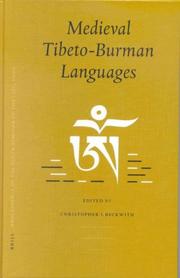
ISBN: 1280466553 9786610466559 1417524588 9047401301 9004124241 9789004124240 9781417524587 9789047401308 Year: 2002 Publisher: Leiden ; Boston, MA : Brill,
Abstract | Keywords | Export | Availability | Bookmark
 Loading...
Loading...Choose an application
- Reference Manager
- EndNote
- RefWorks (Direct export to RefWorks)
This work approaches Tibeto-Burman comparative-historical linguistics according to the classical Indo-European model. Articles are included on: Old Zhangzhung, early classical Newari, Pyu, Old Burmese and early Meithei. Glossaries of several early Tibeto-Burman languages are included.
Tibeto-Burman languages --- Himalayan languages --- Sino-Tibetan languages --- Chin languages --- History
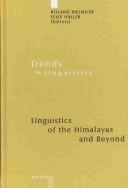
ISBN: 3110968991 9783110968996 3110198282 9783110198287 Year: 2007 Volume: 196 Publisher: Berlin ; New York : Mouton de Gruyter,
Abstract | Keywords | Export | Availability | Bookmark
 Loading...
Loading...Choose an application
- Reference Manager
- EndNote
- RefWorks (Direct export to RefWorks)
The approximately 250 languages of the Tibeto-Burman family are spoken by 65 million speakers in ten different countries including Pakistan, India, Nepal, Bhutan, Burma and China/Tibet. They are characterized by a fascinating linguistic, historical and cultural diversity. The languages spoken in the Himalayas, on their southern slopes and on the high Tibetan plateau in the north constitute the core of this diversity. Thus, the 21 papers mainly deal with these languages and some go even beyond to the area of the Blue Lake in northern Amdo and to southern Kham within linguistic Tibet. The ten papers dedicated to Tibetan linguistic studies offer approaches to the phonological analysis of Balti, to labial place assimilation, perfective stem renovation and stem alternation connected with verbal valence in Amdo Tibetan, to directional markers in Tokpe Gola in northeastern Nepal, to secondary verb constructions in Kham Tibetan, to narrative texts in Dzongkha, to case-marking patterns in various Tibetan dialects and to language history of Tibetan in general. Other papers deal with deictic patterns and narratives in western Himalayan Kinnauri and with the classification of neighbouring Bunan. With the Tamangic languages of northern Nepal the relationship between vowels and consonants and the development of demonstratives and plural markers are addressed. A further paper investigates the genetic relationship between Dzala and Dakpa, two East Bodish languages, and another one case-marking in Rabha and Manipuri in northeastern India. With the Kiranti languages Sampang, Limbu, Chaurasia and Sunwar in eastern Nepal, questions of accent, pronominally marked determiners, subclassification and language shift are discussed. The impressive selection of languages and linguistic topics dealt with in this book underlines the diversity of the Tibeto-Burman languages in Central and South Asia and highlights their place within present-day linguistic research. The results achieved by leading experts are remarkable in general, and the book is of interest to linguists, anthropologists and geographers.
Tibeto-Burman languages --- Himalayan languages --- Sino-Tibetan languages --- Chin languages --- Grammar. --- Himalaya/languages.
Book
ISBN: 9382264523 9789382264521 9788175969308 817596930X Year: 2012 Publisher: New Delhi : Foundation Books,
Abstract | Keywords | Export | Availability | Bookmark
 Loading...
Loading...Choose an application
- Reference Manager
- EndNote
- RefWorks (Direct export to RefWorks)
North East India is one of the most linguistically diverse regions of the world, with over 100, and perhaps as many as 200, different languages spoken. This book aims to produce a volume reflective of both the linguistic diversity of the region as well as the high quality of current research on North East Indian Linguistics. The articles in this volume cover four of the language families represented in North East India: Tai-Kadai, Indo-Aryan, Tibeto-Burman, and Austroasiatic. Divided into seven sections, the book presents the description and analysis of a wide variety of phonological, syntactic, morphological, socio-linguistic and historical topics in the study of several languages of the region origin of the Boro-Garo language family, Boro-Garo grammar, serial verbs in a hitherto undescribed variety of Boro, information about Dimasa dialects, phonology of Hajong, a language of Assam and Meghalaya, and analysis of copula constructions in Assam Sadri. The volume also contains an analysis of pronouns in Madhav Kandalis Ramayana, a version of the Ramayana written in colloquial Assamese of the fourteenth century. The final section in this volume discusses serial verb constructions in the Austroasiatic language war, the most detailed discussion of war syntax and semantics to date.Contributions in this volume range from renowned scholars of Tibeto-Burman linguistics to students from the North East making their first impact in the field of Linguistics. The book will be of interest to linguists, anthropologists, social scientists and general readers with an interest in the study, preservation and appreciation of North East Indian cultural and linguistic diversity.
Tibeto-Burman languages --- Himalayan languages --- Sino-Tibetan languages --- Chin languages --- India, Northeastern --- Northeast India --- Northeastern India --- Languages
Book
ISBN: 9004233458 9789004233454 9789004232020 9004232028 Year: 2012 Publisher: Leiden : Brill,
Abstract | Keywords | Export | Availability | Bookmark
 Loading...
Loading...Choose an application
- Reference Manager
- EndNote
- RefWorks (Direct export to RefWorks)
While providing unique and detailed information on early Tibeto-Burman languages and their contact and relationship to other languages, this book at the same time sets out to establish a field of Tibeto-Burman comparative-historical linguistics based on the classical Indo-European model. The volume includes six papers on Tangut, three on Tibetan and one each on the languages Mon, Burmese, Lepcha, Pyu, Nam, and Yi. Building a bridge between linguistic and literary research the range of studies treats phonology, decipherment, literature and religion.
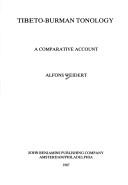
ISBN: 1283313898 9786613313898 9027279063 9789027279064 9027235481 9789027235480 Year: 1987 Publisher: Amsterdam ; Philadelphia : J.Benjamins Pub. Co.,
Abstract | Keywords | Export | Availability | Bookmark
 Loading...
Loading...Choose an application
- Reference Manager
- EndNote
- RefWorks (Direct export to RefWorks)
This monograph lays the foundation for a prosodological theory of Tibeto-Burman languages within a comparative and reconstructional framework. It is primarily based on data collections of mostly unknown languages on which the author worked for more than 10 years on several projects.This comparative study of tonology represents a significant contribution not only to the historical-comparative study of Tibeto-Burman, but also to the larger field of linguistic theory, especially now that the subject increasingly begins to be approached along diachronic lines. With this in mind, it is hoped that t
Tibeto-Burman languages --- Himalayan languages --- Sino-Tibetan languages --- Chin languages --- Tone (Phonetics) --- Tone. --- Phonology, Comparative. --- Phonetics --- Comparative linguistics --- Asian languages
Book
ISBN: 9789004194489 9004194487 9789004216532 9004216537 1283161168 9781283161169 9786613161161 Year: 2011 Publisher: Leiden ; Boston : Brill,
Abstract | Keywords | Export | Availability | Bookmark
 Loading...
Loading...Choose an application
- Reference Manager
- EndNote
- RefWorks (Direct export to RefWorks)
Himalayan Languages and Linguistics gathers together nine outstanding and original contributions on the Tibeto-Burman and Indo-Aryan languages of this important and culturally diverse mountainous area. Filling a marked gap in our understanding of the languages of this underdocumented region, the collection offers a snapshot of the state of the field of Himalayan language research and linguistic comparison. Drawing on primary fieldwork in China, India, Nepal and Pakistan, as well as on comparative sources, the new analyses outlined in these contributions will interest a readership of linguists, philologists, anthropologists, historians, lexicographers and specialists in the languages and cultures of Inner and South Asia. Contributions cover topics as diverse as linguistic palaeontology, orthographical standardisation, dialectology, phonology, morphology, semantics and syntax.
Langues tibéto-birmanes. --- Tibeto-Burman languages. --- Himalaya Mountains Region --- Languages. --- Himalayan languages --- Sino-Tibetan languages --- Chin languages --- Langues tibéto-birmanes
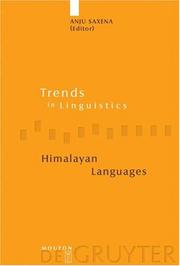
ISBN: 311089887X 9783110898873 3110178419 9783110178418 Year: 2004 Volume: 149 Publisher: Berlin ; New York : Mouton de Gruyter,
Abstract | Keywords | Export | Availability | Bookmark
 Loading...
Loading...Choose an application
- Reference Manager
- EndNote
- RefWorks (Direct export to RefWorks)
With its many and diverse languages, including some with very long documented histories, its great cultural diversity, and its widespread multilingualism - both the stable and transient kind - the Himalayan region is a treasure trove of empirical data for research on language typology and universals, historical linguistics, language contact and areal linguistics. Himalayan Languages contains an overview of Himalayan linguistics, synchronic studies of individual languages, and papers on the historical and areal linguistics of language families and languages in the region, contributed by some of the leading experts in the field.
Tibeto-Burman languages --- Himalayan languages --- Sino-Tibetan languages --- Chin languages --- Himalaya Mountains Region --- Languages --- Langues tibéto-birmanes --- Congresses --- Congrès --- Himālaya --- Langues --- Himalaya
Book
ISBN: 9781783747061 9781783747078 1783747064 1783747072 9781783747085 1783747080 9781783747092 1783747099 9781783747047 1783747048 1783747056 9781783747054 1783747048 9781783747047 Year: 2019 Publisher: Open Book Publishers
Abstract | Keywords | Export | Availability | Bookmark
 Loading...
Loading...Choose an application
- Reference Manager
- EndNote
- RefWorks (Direct export to RefWorks)
This highly original and timely collection brings together case studies from salient areas of the Himalayan region to explore the politics of language contact. Promoting a linguistically and historically grounded perspective, The Politics of Language Contact in the Himalaya offers nuanced insights into language and its relation to power in this geopolitically complex region. Edited by respected scholars in the field, the collection comprises five new research contributions by established and early-career researchers who have been significantly engaged in the Himalayan region. Grounded in a commitment to theoretically informed area studies, and covering Tibet (China), Assam (India), and Nepal, each case study is situated within contemporary debates in sociolinguistics, political science, and language policy and planning. Bridging disciplines and transcending nation-states, the volume offers a unique contribution to the study of language contact and its political implications. The Politics of Language Contact in the Himalaya is essential reading for researchers in the fields of language policy and planning, applied linguistics, and language and literary education. The detailed introduction and concluding commentary make the collection accessible to all social scientists concerned with questions of language, and the volume as a whole will be of interest to scholars in anthropology, sociolinguistics, political science and Asian studies.
Tibeto-Burman languages. --- Himalayan languages --- Sino-Tibetan languages --- Chin languages --- Himalaya --- Himalayan region --- politics of language contact --- Tibet --- Assam --- Nepal --- sociolinguistics --- political science --- Himalaya Mountains Region --- Languages.
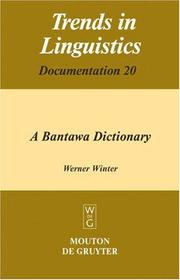
ISBN: 3110898314 9783110898316 3110177102 9783110177107 Year: 2003 Publisher: Berlin ; New York : Mouton de Gruyter,
Abstract | Keywords | Export | Availability | Bookmark
 Loading...
Loading...Choose an application
- Reference Manager
- EndNote
- RefWorks (Direct export to RefWorks)
Bantawa, spoken in Eastern Nepal, is the most widely used of the Rai languages, an important subgroup of the Kiranti group of Tibeto-Burman languages. This dictionary, based on material obtained in the context of the Linguistic Survey of Nepal, concise though it is, stands out as the most voluminous of the few dictionaries and word lists for Rai languages that were hitherto published with English equivalents of native forms provided. The fact that both a Bantawa-English and an English-Bantawa part give access to the forms makes the book an important research tool for specialists in Kiranti languages as well as for scholars concerned with Tibeto-Burman and Nepal studies in general.
Bantawa language --- Kiranti languages --- Bahing-Vayu languages --- East Himalayan languages --- Tibeto-Burman languages --- Bāntavā language --- Bantawa Rai language --- Bontāvā Khambū language --- Bontāvā language --- Bontawa Khamboo language --- Bontawa language --- Kirāta Rāī language
Book
ISBN: 9004350519 9789004350519 9789004349834 9004349839 Year: 2017 Publisher: Leiden : Koninklijke Brill NV,
Abstract | Keywords | Export | Availability | Bookmark
 Loading...
Loading...Choose an application
- Reference Manager
- EndNote
- RefWorks (Direct export to RefWorks)
Sociohistorical Linguistics in Southeast Asia blends insights from sociolinguistics, descriptive linguistics and historical-comparative linguistics to shed new light on regional Tibeto-Burman language varieties and their relationships across spatial, temporal and cultural differences. The approach is inspired by leading Tibeto-Burmanist, David Bradley, to whom the book is dedicated. The volume includes twelve original research essays written by eleven Tibeto-Burmanists drawing on first-hand field research in five countries to explore Tibeto-Burman languages descended from seven internal sub-branches. Following two introductory chapters, each contribution is focused on a specific Tibeto-Burman language or sub-branch, collectively contributing to the literature on language identification, language documentation, typological analysis, historical-comparative classification, linguistic theory, and language endangerment research with new analyses, state-of-the-art summaries and contemporary applications.
Tibeto-Burman languages. --- Sociolinguistics --- Historical linguistics --- Diachronic linguistics --- Dynamic linguistics --- Evolutionary linguistics --- Language and languages --- Language and history --- Linguistics --- Language and society --- Society and language --- Sociology of language --- Language and culture --- Sociology --- Integrational linguistics (Oxford school) --- Himalayan languages --- Sino-Tibetan languages --- Chin languages --- History --- Social aspects --- Sociological aspects --- Bradley, David, --- Southeast Asia --- Languages.
| Listing 1 - 10 of 10 |
Sort by
|

 Search
Search Feedback
Feedback About UniCat
About UniCat  Help
Help News
News